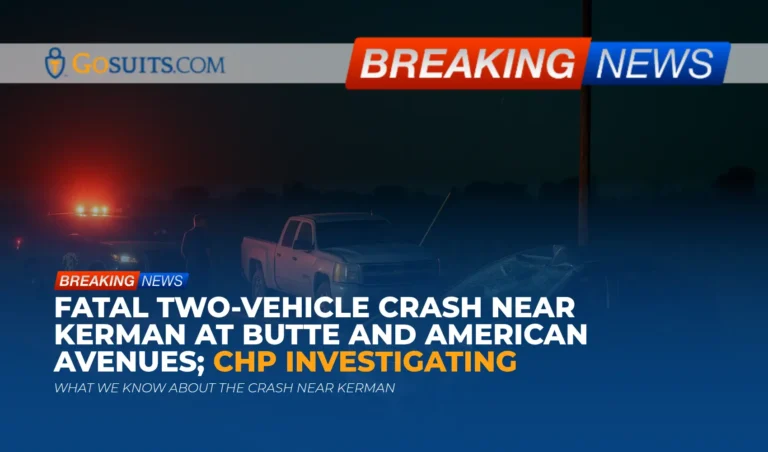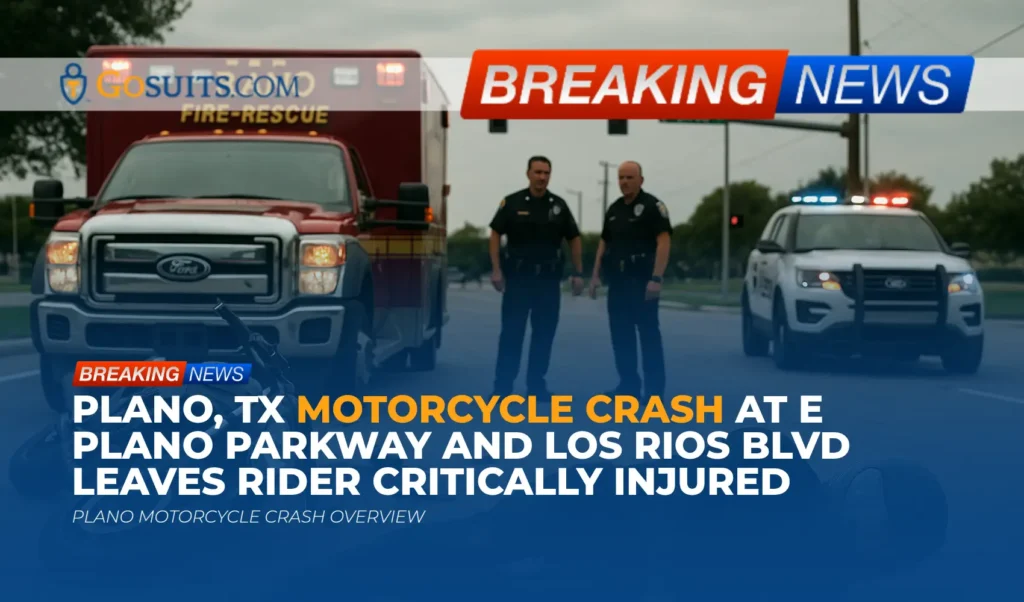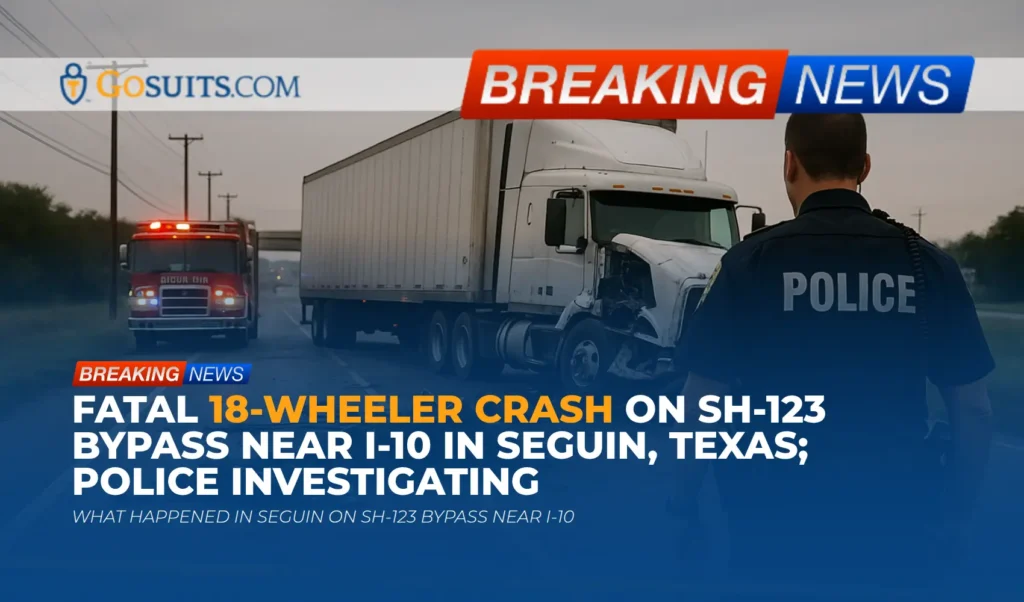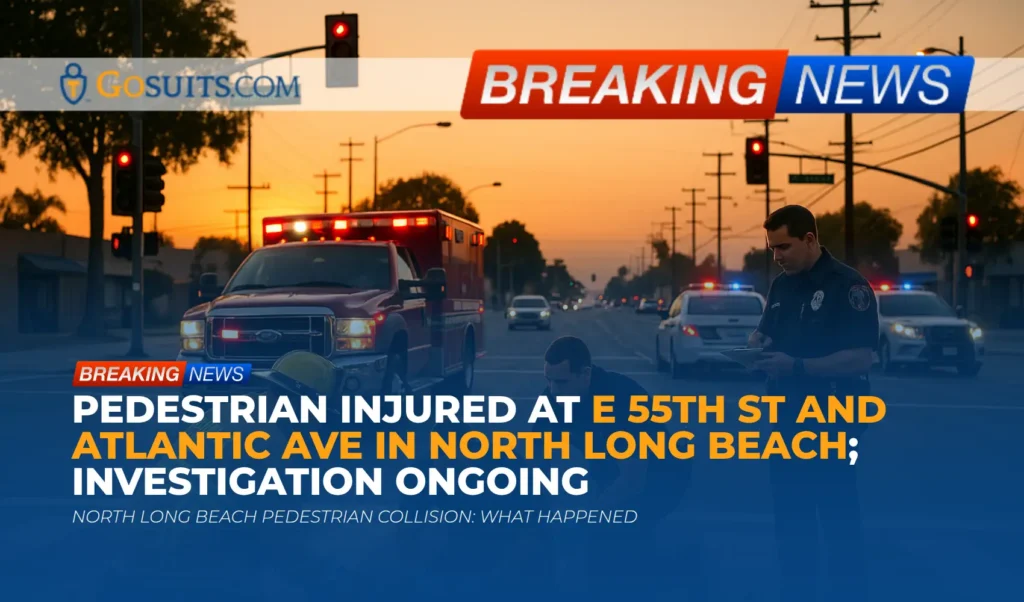- What we know about the crash near Kerman
- Where, when, and who was involved
- Investigation status and what it means
- Roadway rules that matter at this intersection
- Potential civil liability and victims’ rights
- Key records to request and who to contact
- Insurance and claims considerations
- Timelines and legal deadlines in California
- Preserving evidence after a serious crash
- Community safety context for intersection crashes
- Commentary from Gosuits Kerman, California Personal Injury Attorney
- Action steps to consider now
What we know about the crash near Kerman
A two-vehicle crash occurred around 8 p.m. at the intersection of Butte Avenue and American Avenue, southwest of Kerman. According to preliminary information from the California Highway Patrol, a southbound 2007 Chevrolet Silverado did not stop at a posted stop sign on Butte Avenue and entered the intersection. A westbound 2017 Honda Civic traveling on American Avenue, which is not controlled by a stop sign at this intersection, collided with the Chevrolet.
The impact pushed the Honda off the roadway into a dirt field, where it overturned and came to rest on its wheels. The Chevrolet continued into a nearby field and struck a power pole guy wire. The adult male driver of the Chevrolet got out of his vehicle and collapsed at the scene. He was airlifted to Community Regional Medical Center and later passed away. The 20-year-old woman driving the Honda, from San Joaquin, sustained minor injuries and was also transported to Community Regional Medical Center. Both drivers were wearing seatbelts. CHP reported that alcohol or drugs do not appear to be factors at this time. The CHP Fresno Area Office is continuing the investigation.
Where, when, and who was involved
Location
The collision occurred at the rural intersection of Butte Avenue and American Avenue, southwest of Kerman in Fresno County, California. American Avenue at this location operates without a stop sign for through traffic, while Butte Avenue traffic is controlled by a stop sign.
Time
The crash took place Monday evening at approximately 8 p.m.
Involved parties
Two drivers were involved:
- Chevrolet Silverado: A 30-year-old man from Kerman was driving southbound on Butte Avenue. He was airlifted and later died from his injuries.
- Honda Civic: A 20-year-old woman from San Joaquin was driving westbound on American Avenue. She sustained minor injuries.
Identities beyond age and city of residence are not included here for privacy and respect, though CHP has publicly identified the deceased driver in news reports. Families often choose how and when to share names more widely, and this article honors that choice.
Investigation status and what it means
CHP’s Fresno Area Office is investigating. In a case like this, investigators typically examine vehicle damage, roadway markings, skid or yaw evidence, debris distribution, airbag module data if available, statements from involved drivers and witnesses, and any nearby camera footage. They also document visibility and signage conditions, including whether a stop sign was unobstructed and properly placed.
Even when alcohol or drugs are not suspected, standard investigative steps can include requesting toxicology records and medical documentation to complete official reports. The process can take several weeks. A formal Traffic Collision Report is usually released to authorized parties once complete.
Families sometimes assume a police press release is the final word. It is not. The full report, diagrams, and any supplements provide a much clearer picture of causation, speeds, and right-of-way dynamics. If questions arise about signage, line of sight, or roadway conditions, those issues can be explored through public records and, when appropriate, independent experts retained by counsel.
Roadway rules that matter at this intersection
Stop sign duty in California
California law requires drivers to stop at posted stop signs and yield the right-of-way to vehicles that have entered the intersection or are approaching closely enough to constitute an immediate hazard. See California Vehicle Code section 22450. The California Driver Handbook also explains right-of-way expectations, including how drivers at stop-controlled approaches must proceed only when safe to do so. See the DMV guidance on right-of-way here.
Right-of-way on a through roadway
When only one leg of an intersection is stop-controlled, the through roadway without a stop sign generally has the right-of-way. A driver entering from the stop-controlled approach must make a complete stop and may proceed only when the way is clear and safe, yielding to traffic on the through road.
Why these rules matter for civil liability
In civil cases, a violation of a safety statute can support a theory of negligence per se, which means the law itself helps define the standard of care. Whether negligence per se applies depends on evidence and the circumstances. Even so, California permits juries to allocate responsibility between multiple actors under comparative fault principles. The Judicial Council’s Civil Jury Instructions discuss comparative fault in general terms, allowing responsibility to be shared when appropriate. See the California Courts’ CACI resource page here.
Potential civil liability and victims’ rights
For the injured driver in the Honda
Based on initial reports, the Honda was traveling on a through road without a stop sign, and the Silverado entered the intersection from a stop-controlled approach without stopping. In many cases with similar facts, the driver who fails to stop may bear primary responsibility for the collision. The injured Honda driver may pursue a bodily injury claim for medical expenses, lost income, and other legally compensable losses against the at-fault party’s insurance.
However, every collision is fact-specific. Issues that can affect liability include speed on the through road, lighting and visibility at 8 p.m., condition and visibility of the stop sign, and whether any third parties contributed to a dangerous condition of the intersection. California’s comparative fault rules can allocate responsibility among multiple parties when the evidence supports it.
For the family of the deceased driver
When a driver is alleged to have caused a crash, loved ones sometimes assume there is no civil path forward. That is not always the case. California law allows certain surviving family members to bring a wrongful death claim when a third party’s negligence contributed to a fatal collision. Potential third parties could include a public entity if a dangerous condition of public property played a substantial role, or another driver if additional causes are identified. Public entities are not responsible for every collision at a rural intersection, but questions sometimes arise about signage placement, maintenance, vegetation obstructing sight lines, inadequate lighting, or prior notice of similar incidents. These are fact-driven analyses that benefit from early investigation.
California also recognizes a survival action on behalf of the decedent’s estate for certain losses the decedent sustained before death. See Code of Civil Procedure section 377.30. For wrongful death, see Code of Civil Procedure section 377.60. Determining which claims apply requires a careful review of the facts.
Public entity considerations
If evidence supports a claim that a dangerous condition of public property contributed to the crash, California’s Government Claims Act requires a written claim with the public entity within a short deadline in most cases. See Government Code section 911.2. Missing this administrative deadline can affect the ability to pursue a lawsuit later.

Key records to request and who to contact
CHP Traffic Collision Report
The CHP Traffic Collision Report is a foundational document. It includes the investigating officer’s findings, diagrams, statements, and any cited violations. Authorized requestors typically include involved drivers, their legal representatives, and next of kin.
- How to request: CHP describes the process for obtaining a traffic collision report on its website. See the CHP’s guidance here.
- Office locator: To identify or contact the CHP Fresno Area Office handling the case, use the CHP office locator here.
- What to have ready: Date, time, location, involved names, and if available the CHP report number. Allow processing time, as reports are not immediate.
Coroner and autopsy records
Because this collision involved a fatality, the county coroner typically opens a case. Families may request information about the cause and manner of death, and eventually the autopsy and toxicology reports when available. In Fresno County, coroner functions are administered by the Sheriff-Coroner. Contact information can be found through the Fresno County government website. Start at Fresno County’s official site and navigate to the Sheriff-Coroner section to locate the Coroner Unit’s contact and records request instructions. Be prepared to provide proof of relationship if you are requesting records as next of kin.
Medical records
Medical records from Community Regional Medical Center and any other providers document injuries, treatment, and prognosis. Under federal privacy rules, a patient or a personal representative has rights to access health records. The U.S. Department of Health and Human Services explains personal representative rights under HIPAA here. Hospitals generally have a Health Information Management department with release-of-information forms and instructions. For deceased individuals, the personal representative of the estate typically manages access.
911 audio, dispatch logs, and road maintenance records
- Dispatch audio and logs: Families sometimes seek 911 recordings and Computer Aided Dispatch logs for timing and response details. Requests are made to the agency that handled dispatch. In many rural parts of Fresno County, that may be a county or sheriff-run communications center. Use the county’s public records portal or contact the relevant agency’s records unit.
- Roadway records: If there are concerns about signage or visibility, road maintenance and traffic engineering records can be requested from the Fresno County Department of Public Works and Planning through public records procedures on the county’s website.
Insurance and claims considerations
Speaking with insurance companies
Insurance adjusters often ask for recorded statements quickly. What is said can be used to minimize or dispute a claim later. It is wise to consult with a qualified attorney before giving recorded statements to any insurance carrier. This includes your own insurer for uninsured or underinsured motorist benefits, medical payments claims, or collision coverage, as well as any insurer for the other driver.
Property damage and total loss
Severe impacts like an overturn can lead to total loss determinations. Keep detailed photographs of exterior and interior damage. Do not rush to dispose of a vehicle without guidance, especially when liability or defect investigations are ongoing. Preserving the vehicle preserves critical evidence, including event data recorder information in some vehicles.
Accident reporting to DMV
California requires an SR-1 report to the DMV within 10 days if anyone is injured or killed, or if property damage exceeds a threshold set by the state. The DMV explains accident reporting requirements here. If an SR-1 is required, carefully review it with counsel, because statements in official forms can carry weight.
Coverage layers to check
- Liability coverage: From the at-fault driver’s policy.
- Uninsured/underinsured motorist: From the injured person’s own policy if the at-fault driver’s coverage is insufficient.
- Medical payments: Optional coverage that can help with immediate medical bills regardless of fault.
- Potential third-party coverage: If evidence supports a claim involving a public entity or utility related to road conditions or roadside hazards, different notice rules and coverage issues apply.
Timelines and legal deadlines in California
- General personal injury and wrongful death statute: Most claims must be filed within two years of the incident. See Code of Civil Procedure section 335.1.
- Claims involving public entities: Written claims usually must be presented within six months in many personal injury and wrongful death matters. See Government Code section 911.2.
- Insurance notice provisions: Policies often require prompt notice of a loss. Missing a policy deadline can affect coverage, so review policy language carefully and coordinate notice through counsel.
These are general time frames and there are exceptions and nuances. Early action helps preserve options.
Preserving evidence after a serious crash
Evidence can fade quickly after a rural intersection crash. Headlights and taillights get repaired, road debris is cleared, and vegetation grows or is cut back, changing sight lines. Preserving proof early strengthens any eventual claim and can also help families understand what happened.
- Photograph the scene: Capture the intersection from multiple angles, at a similar time of day and lighting conditions if possible. Include the stop sign condition, its height, visibility, and any obstructions.
- Obtain vehicle inspections: Before repairs or disposal, consider an independent inspection of both vehicles if access is available. Event data recorders may contain speed and braking data.
- Locate witnesses and cameras: Rural intersections sometimes have nearby residences, farms, or utility installations. Ask about doorbell, barn, or security cameras that may have captured approach paths or the crash sequence.
- Request public records: Submit timely requests for the CHP collision report and, if appropriate, roadway maintenance and traffic engineering files.
- Track medical care: Keep all discharge summaries, imaging, and bills. A complete medical file helps document the full impact of the crash.

Community safety context for intersection crashes
Intersections remain a major source of serious collisions nationwide. The Federal Highway Administration notes that intersection safety is a national priority and that a significant share of severe crashes occur at or near intersections. See FHWA’s overview of intersection safety here. In rural areas, limited lighting, higher approach speeds, and driver unfamiliarity with stop-controlled cross streets can compound risks, especially after dark.
On roads like American Avenue that function as through corridors, clear stop sign visibility for cross traffic is critical. Vegetation growth, faded sign faces, missing retroreflective strips on posts, or misaligned signs can reduce compliance. While CHP’s early reports indicate the Silverado failed to stop, part of a thorough civil review is confirming whether all traffic control devices were present, visible, and compliant with standards at the time.
Seatbelt use, reported by CHP in this incident, remains one of the most effective protective factors in reducing serious injury. Even with seatbelts, however, the physics of a side-impact crash at rural road speeds can be severe, particularly for the vehicle struck in the side or for vehicles that leave the roadway and overturn.
Commentary from Gosuits Kerman, California Personal Injury Attorney
Our hearts go out to everyone affected by this tragic crash near Kerman. A life was lost, and another young driver was injured. This article is provided for educational purposes and general information so that community members can better understand the civil issues that often follow a serious collision.
From a civil perspective, early reports suggest a stop sign violation at a rural intersection where the cross traffic had the right-of-way. In many cases with similar facts, the driver who failed to stop is primarily at fault. That said, experienced civil practitioners do not stop at the first headline. They look carefully at the intersection’s history, sign placement and visibility, lighting, approach speeds, and sight distances. If a dangerous condition of public property or another contributing factor is present, those facts matter for accountability and for preventing future harm.
Insurance companies and large organizations often move fast after a crash. Adjusters may request recorded statements right away, ask broad medical questions, or push quick settlements before the full scope of injuries is known. They are trained to minimize what they pay on claims. Without guidance, people can inadvertently say or sign things that limit their rights. Having a confidential, free consultation with a seasoned personal injury attorney can help clarify options, protect against common pitfalls, and ensure critical evidence is preserved while memories are fresh.
Action steps to consider now
- Secure the official records: Request the CHP Traffic Collision Report once available and track any supplements. Obtain medical records and billing from all treating providers. For fatalities, request coroner case information and, when ready, autopsy and toxicology results.
- Preserve vehicles and evidence: Do not dispose of or repair vehicles until evidence is documented. Photograph the intersection, signage, and any sight obstructions at a similar time of day.
- Avoid recorded statements before counsel: Insurance carriers will often call quickly. Consult with an attorney first. What is said can be used to dispute fault or the extent of injuries later.
- Track all losses in writing: Maintain a journal of symptoms, missed work, appointments, mileage to medical visits, and out-of-pocket expenses. Organized documentation strengthens a claim.
- Calendar critical deadlines: Note the two-year statute for injury and wrongful death claims in California and the much shorter six-month claim deadline for public entity matters. Early investigation is essential if roadway conditions are in question.
- Coordinate mandatory reporting: If an SR-1 to the DMV is required due to injury or damage thresholds, prepare it carefully and consider counsel review before submission.
- Identify all insurance layers: Confirm liability, uninsured or underinsured motorist, and medical payments coverages. Request policy declarations so that all potential benefits are understood.
- Consider grief and recovery support: Serious crashes affect entire families. Seeking counseling, community, and medical support is a sign of strength. Healing and careful legal steps can proceed in parallel.
Taking these steps promptly can make a meaningful difference. Evidence and memories are freshest in the days and weeks after a crash, and certain deadlines are strict. A free, confidential legal consultation can help clarify the best path forward without any obligation or risk.






